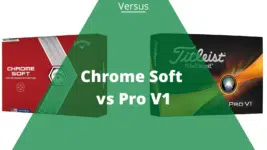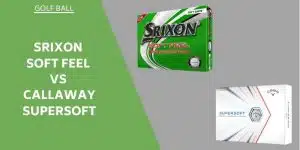Being a high proponent of the companies golf balls, I recently took it upon myself to review the Titleist Velocity vs Pro V1 to see which options are best suited for your game.
Things to consider before buying golf balls
While all golf balls are round, they are crafted from different materials and vary in price, weight, and size.
Here are a few tips to help you save time, money, and make the right decision the next time you are in the market for new golf balls.
Budget
The cost of golf balls ranges significantly, depending on the quality, performance, and brand. Beginners who are at a higher risk of frequently losing balls should look at the budget options or capitalize on bulk sales.
Entry-level to the middle of the range balls will set you back approximately $2 per unit. Premium quality products will cost you more than $4 per ball.
If those prices are out of your budget, I recommend hunting for second-hand balls. Bear in mind the quality and performance of second-hand products can be a hit or miss.
Spin
You must consider the type of spin you are looking for in a golf ball. If you want a ball with lower spin levels from tee to green, think about a product fitted with ionomer polymers. If you need high levels of spin when it comes to your short game and putts, it is better to consider urethane covers.
Urethane covers give the ball a softer feeling, improving spin and bite on the green.
Distance
It is challenging to have everything when it comes to your golf ball. In the past, we had to sacrifice distance for spin and vice versa, which was frustrating for us average golfers.
With the advancement of technology, manufacturers now offer us balls that reduce spin with a driver and long iron and enhances spin in your short game.
These balls typically have a urethane cover to increase durability and an ionomer casing unit. The firmer ionomer casing gives the ball firmness to help enhance ball speeds.
If you want a ball built purely for distance, I recommend searching for products with ionomer covers. The hard cover is designed to lower spin and increase your flight, resulting in longer distances.
Colors
Traditionally, we have turned to white golf balls to get us through 18 holes. While varying colors of balls have entered the market in the past two decades, there is a perception that their quality is inferior.
These days even premium golf balls are available in color. The most popular alternative to white is yellow, designed to stand out in the rough. This is particularly useful for players that no longer operate on 20/20 vision.
Other popular colors include matte red, matte orange, and matte green. Traditionalists may find the colors distracting at set up and might opt for white balls. But, if you feel like letting your inner Ian Poulter out, why not go for some color.
Titleist Velocity
The Titleist Velocity is another creation from the legendary manufacturer that works from the tee to the green. The Velocity promotes low spinning drives and long iron shots, combined with a high flight for softer landings on the green.
Below are the features of the Velocity that I found may benefit your game.
Features & Benefits
Larger Higher Speed LSX Core
The large core of the Velocity was designed to give you a powerful launch. A solid launch leads to a higher ball flight, resulting in further carry and more distance.
During my testing, I found that the Velocity carried only 2 yards further on average. That included shots with my driver, middle, long and short irons.
The higher speed core is ideal if you struggle to generate fast ball speeds and require the added length.
Faster Cover
The Titleist Velocity is fitted with a surlyn ionomer cover, employed to harden the ball. The Velocity’s cover maximizes your ball speed and lowers your spin rpm on longer shots.
I found that my ball speed on drives and long iron shots with the Velocity was 3 mph faster than with a Pro V1. That changed when it came to my wedge shots, where the Velocity was 2 mph slower on average than the Pro V1.
When it comes to distance with the Velocity, my shots ended 2 yards further throughout the bag.
The backspin I achieved with the Velocity was comparable to the Pro V1 on drives and long iron shots. However, my wedge shots were a different story. My backspin rate was over 4000 rpm lower when I used the Velocity.
Color and Cost
Unlike the Pro V1 that only comes in white and yellow, the Velocity gives you an array of colors from which to choose. Titleist give you the option of acquiring these balls in white, matte pink, orange, and green.
A box of a dozen Velocity’s fetches $28 on Titleist.com.
Titleist Pro V1
The Pro V1 has been my go-to ball for close to a decade. It is one of only a handful of balls that I have found, offers me an acceptable distance off the tee and intense spin on the greens.
The balance of distance and spin in the Pro V1 is the likely reason that over 80% of tour players use Pro V1 or Pro V1x every week.
I have compiled a few features of the Pro V1 that you may find beneficial to your game, from tee to green.
Features & Benefits
Cast Urethane Cover
The Pro V1 was crafted using a thinner cast thermoset urethane cover. The cover is 17% narrower than previous Titleist balls and generates increased spin on chips and approach shots.
My spin rpm was less than 100 slower with the Pro V1 on mid-iron shots versus the Velocity. However, I achieved 4000 rpm higher of backspin when I hit the Pro V1 with my wedge, compared to the Velocity.
The enhanced backspin resulted in my mid-iron and wedge shots stopping dead. As a result, I found this helped my distance control and left me with more birdie putts.
Ionomer Casing Unit
An ionomer is a rigid polymer used in the construction of distance golf balls. The solid material reduces spin on drives and long iron shots, increasing your distance.
Titleist inserted an ionomer casing unit on the inside of the Pro V1 to give you distance features in a ball designed to spin.
On average, my drives using a Pro V1 came up 2 yards short of the Velocity’s total distance. I received minimal run on my longer shots, gaining an average of 1 yard after the ball landed.
Color and Cost
Titleist has made Pro V1’s available in white and yellow. A dozen balls are going at $45, which you can acquire on Titleist.com. Keep in mind that the price of one box of Pro V1’s is almost the same as two dozen velocity balls.
Alternatives to the Titleist Velocity vs Pro V1
1. Titleist Pro V1x
The features of the Pro V1x are similar to those of the Pro V1. The Pro V1x is also constructed using a 17% thinner cast urethane cover, which offers high levels of spin on approach shots.
Furthermore, the speed-enhancing ionomer casing unit is installed to promote quicker ball speed, further carry, and better distance. The large casing layer of the ball maximizes speed and lowers spin on long shots.
I have found that I generate more spin with the Pro V1x versus the Pro V1, but as a result, I lose a couple of yards.
As is the case with the Pro V1 and the Velocity, you can select this ball in white or yellow. If this is the ball for you, be prepared to cough up $44 per dozen on Titleist.com.
2. Titleist AVX
We have seen Titleist’s shift towards hybrid balls that offer you sufficient distance and spin. Internally the AVX is fitted with a large core. Externally, it presents a thin urethane cover containing aerodynamic dimples. This gives you a piercing low flight, reducing your spin on longer shots.
The soft feeling urethane cover enhances the balls spin ability on shots to and around the green. As we have seen with other Titleist balls, you can purchase the AVX’s in white or yellow. They are slightly higher in price than other balls that we have looked at, fetching $50 for a dozen on Titleist.com
3. Titleist Tour Speed
The Tour Speed is another example of Titleist’s mission to produce golf balls that offer distance off the tee and spin around the greens. The 3-piece ball is crafted using a urethane polymer on the cover, an ionomer casing layer, and a fast core.
The durable urethane cover protects the ball and gives it a soft feel. The softness of the urethane enables the ball to dig deep into the grooves of the clubface. This causes more friction and increases your trajectory, landing, and spin on the greens.
Titleist employed a technology-driven core in the Tour Speed to increase ball speed at impact. The brand claims this core is faster than that of any other ball on the market. Additional ball speed at impact helps you send the ball airborne, gaining further carry and distance.
The Titleist Tour Speed is only available in white, and $40 will bag you a dozen balls on Titleist.com.
Final Thoughts
Even after this test, I have no doubt that the Pro V1 is still the ball for my game. That being said, I do need to give this round to Velocity based on price.
In terms of performance, the results were comparable throughout. The velocity averaged 2 yards further than the Pro V1 with a driver and longer irons.
When it came to wedge shots, the Pro V1 bit into the green quicker than the Velocity. Considering that it is $17 less than the Pro V1, it performs as if it were in the same class.
This is why the Velocity wins in our review of the Titleist Velocity vs the Pro V1. You get a comparable performance for less.
If you want a ball with the distance and spin of the Pro V1 at a fraction of the price, check out the Titleist Velocity here.
Related Articles
- Pro V1x vs TP5X Tried & Tested For You
- Low Compression Golf Balls – And The Pros & Cons of Using Them
- Titleist AVX Golf Ball Review; How Do These Balls Stack Up?
Nick is the founder of GolfSpan and an avid golfer. He's not quite a pro but has over 15 years of experience playing and coaching golfers worldwide. His mission is to bring the golfing community a better experience when it comes to choosing the right golf gear and finding the right setup for your game.






